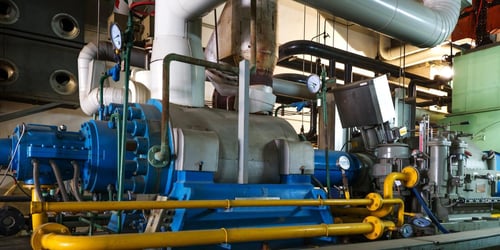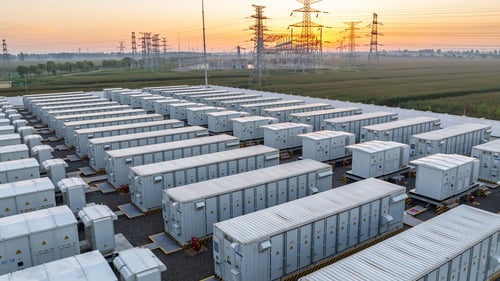Empowering Industry through Energy Flexibility - Q&A with Raphaël Gras

Jump to:
- Trends affecting industrial companies in the energy transition
- How flexibility helps industrials address these challenges in the short-term
- Now is a decisive moment for industrial flexibility
- Concrete use cases for industrial companies
- Key enablers of greater flexibility in the future
Unlock New Revenue Streams with Demand Response
Check out our essential guide to energy flexibility.
What trends do you see affecting industrial companies in the energy transition?
The European industry today is experiencing a sea change with the shift away from fossil fuels toward electrification.
However, the EU power system currently doesn’t make this process easy for industrials. Compared to the US or Asia, European companies are exposed to structurally higher electricity prices and have been hit harder by recent external shocks.
Meanwhile, insufficient grid capacity, combined with a backlog of administration, has made it challenging to meet demand for new grid connections. All of this makes the electrification of industries difficult and costly.
Yet, industrials have been extremely active in adapting, essentially around three dimensions: direct procurement of renewable electricity (Power Purchase Agreements or PPAs), energy efficiency programs, and investment in on-site energy production & storage.
How can flexibility help industrials address these challenges in the short-term?
Many industrial processes are flexible in their electricity consumption. They can be temporarily reduced or rescheduled without impacting production outputs.
This can be leveraged to balance demand and supply on the electricity grid. In practice, if an imbalance happens, industrials would adjust consumption based on a signal from grid operators — and grid operators would remunerate them for doing this!
Some programs are backup reserves for extreme cases, meaning that grid operators will very rarely send activation signals. This means you get paid with minimal disruption to processes. But there are also ways to increase revenues with more activations in other programs.
These revenues from grid services end up in the plant’s financial statements or investment cases, eventually reducing the average cost of each MWh to run electric assets. This is a key lever to improving the competitiveness of electrification compared to fossil fuels.
For example, many businesses are already replacing gas boilers with electric boilers to produce heat. They are a great fit to provide grid services, making them both a profitable investment for businesses and a cleaner alternative to gas.
Why are we now at a decisive moment in Europe for Industrial Flexibility?
We are approaching key tipping points in the penetration of intermittent renewables in the European grid. In 2023, roughly 30% of electricity in Europe came from wind and solar. In some countries, like the Netherlands, the installed capacity of solar generation is reaching the same level as peak demand. This creates enormous challenges to the system.
Electricity in Europe is traded on markets, and its price varies every hour based on the balance of supply and demand. Historically, demand was the main reason for prices to change during the day because generation from coal or nuclear was always available. But now, with such a large amount of wind and solar energy, the weather has become the main driver of price.
The implication for industrial consumers is that the ones that can best anticipate electricity prices, consume more when it is abundant and less when it’s scarce, will have lower bills. They will also have lower carbon footprints. In the end, they will build a competitive edge through energy.
What concrete use cases industrial companies implement to strive under this new energy paradigm?
We will shift towards an increasingly proactive use of flexibility. To benefit from the price variability that intermittent renewables bring, you need to plan electricity consumption accordingly.
This is what we call load-shifting or load management. In practice, it means phasing consumption based on electricity prices during the day. It is already a common practice among large energy consumers like industrials. But with increased volatility, price forecasting is requiring unprecedented levels of sophistication.
In parallel, industrials must build as much buffer as possible in the electricity consumption of their processes to increase their ability to be flexible. This can be done with investment in dedicated assets, particularly thermal storage or batteries. Here, digitisation can also help to plan operations dynamically to maximise flexibility.
The good thing is that these actions are synergistic with grid services. For example, you can use thermal storage combined with electric boilers to increase revenues from grid balancing. This creates a virtuous cycle of lower electricity costs and increased revenue, further reinforcing the competitive position down the line.
What are the key enablers of greater flexibility in future?
Well, first, we need to ensure that industrial consumers are exposed to the hourly price signal to incentivise them to be flexible. So, dynamic and spot-indexed electricity contracts must continue to be rolled out. Energy suppliers will have to innovate to offer a broader range of options, matching the diversity of industry needs.
Then, we need to foster entrepreneurship in the flexibility services space. In Europe, we have the chance to benefit from an ecosystem of over 100 flexibility services providers that have been extremely innovative in the last two decades. However, they still face many regulatory barriers to participating in all energy markets in a non-discriminatory way. These barriers need to be lifted.
Eventually, we need to reinforce the link between energy management and sustainability. In Europe, lower electricity prices often mean a lower carbon footprint from the electricity supply. Reducing emissions is also a key stake for industries. We must increase transparency and awareness of how renewable energy works and how being flexible enough to consume it can make industries win in all dimensions.
Ready to unlock new revenue with Demand-side Flexibility? Contact us!
Other articles you might find interesting
-
 Demand-side flexibility2 July 2024
Demand-side flexibility2 July 2024District Heating Operators: New Revenue From Grid Balancing
Read more -
 Demand-side flexibility2 July 2024
Demand-side flexibility2 July 2024Five Myths About Demand Response, Debunked!
Read more -
 Demand-side flexibility2 July 2024
Demand-side flexibility2 July 2024BESS & Demand Response, What’s the Connection?
Read more -
.jpg?length=500&name=Article%20Thumbnails%20-%201920x1080%20new%20website%20(4).jpg) Demand-side flexibility2 July 2024
Demand-side flexibility2 July 20243 Things to Look for in a Flexibility Service Provider
Read more -
.jpg?length=500&name=Article%20Thumbnails%20-%201920x1080%20new%20website%20(35).jpg) Demand-side flexibility2 July 2024
Demand-side flexibility2 July 2024smartEn Executive Director Michael Villa on the future of energy flexibility in Europe
Read more -
.jpg?length=500&name=Article%20Thumbnails%20-%201920x1080%20new%20website%20(34).jpg) demand response2 July 2024
demand response2 July 2024Getting Europe’s Grids Fit for the 21st Century - Interview With SmartEn’s Executive Director Michael Villa
Read more -
 demand response2 July 2024
demand response2 July 2024EU elections: Opportunity or Risk for Demand-Side Flexibility? - Q&A with Mathilde Chareyron
Read more -
.jpg?length=500&name=Article%20Thumbnails%20-%201920x1080%20new%20website%20(5).jpg) Knowledge2 July 2024
Knowledge2 July 2024How to Earn Revenue with Demand Response
Read more -
.jpg?length=500&name=Article%20Thumbnails%20-%201920x1080%20new%20website%20(6).jpg) Demand-side flexibility2 July 2024
Demand-side flexibility2 July 2024Five Times Demand Response Saved the Grid
Read more